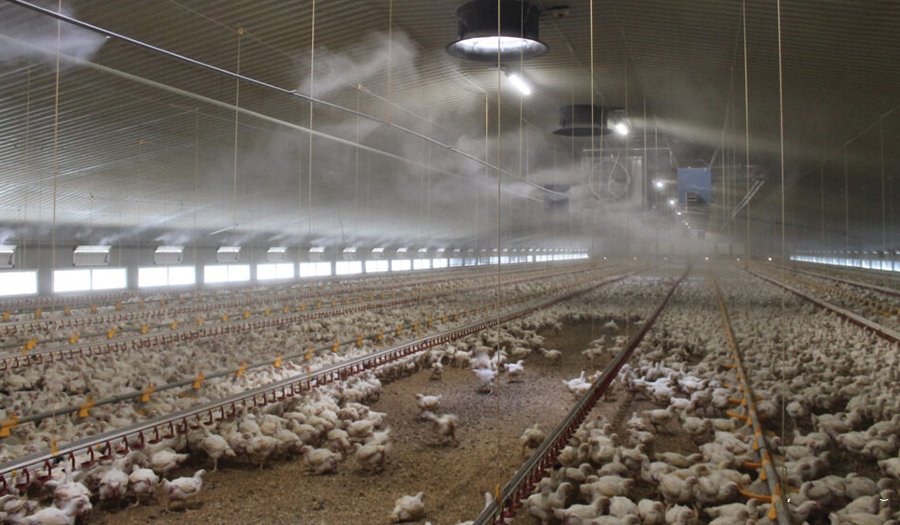Daily misting of broiler sheds lifts bird performance
Farmers Weekly

Misting systems are becoming increasingly common in broiler houses as the industry gears up for hotter summers and greater welfare scrutiny.
For many growers, they provide a useful backup for those days when the mercury rises and shed temperatures become dangerously high.
But for Nigel Edwards of Whittal Poultry, the 2023 Farmers Weekly Poultry Farmer of the Year, misting the sheds has become part of the daily routine, delivering both physical and financial benefits for the business.
“We run the system every single day, at 8am sharp, giving each shed a 20-second blast to create a better atmosphere, and as a disease precaution,” he says.
The four sheds Nigel manages at Court Barns in Herefordshire were put up in 2019 – some of the last sheds to be built in the recent spate of poultry expansion in the area.
“It was actually when Avara Foods requested a year or two later that its contracted growers install misting systems that we started looking at the options,” he says.
“While some producers went for cheaper designs, we went for a more robust system that would withstand the challenges of the environment.”
That was a Lubing system, which runs down the middle and sides of each shed and is linked to the farm’s Dosatron pumps.
The system has been set up in partnership with Independent Water Solutions and uses their patented Xziox disinfectant, which feeds both the drinking lines and the misting system.

Temperature control
The obvious benefit is its effect on shed temperature, knocking it down by about 3C during the summer months, which is good for bird comfort and performance.
“For the first year, we only ran it during the warmer weather,” says Nigel. “But the birds seemed to like it and I could see other advantages.”
The birds are considerably more active, getting up and moving about when the unit switches on each morning, and there has been a notable reduction in feet and leg problems.
“Our last two flocks have had the lowest pododermatitis scores ever,” he says. “Avara pays a premium for anything below 20% and we are now down at 12%.”
Of course, the whole environment has to be watched closely.
“If humidity levels got too high, it could lead to wet litter. If they got too low, it could become dusty and the birds might not perform,” says Nigel. “My target is 60% humidity.”
Bird mortality figures also seem to have benefited from the introduction of misting, with the inclusion of the disinfectant reducing airborne pathogens, though there has also been an improvement in chick quality from the hatchery.
The last flock recorded a mortality rate of just 2.35%, while the average slaughterweight was 2.52kg – 7% ahead of the breed target.
Running the misting system every day also avoids the build-up of stagnant water, which can increase the risk of legionella infection.
Performance
Initial investment for the misting system came to about £50,000, including installation across all four sheds. It also uses more product – both water and chemical – which adds up.
And there is the extra electricity to consider – though with 450kW of solar panels on two of the sheds’ roofs, and 387kW of lithium battery storage recently installed, it is a cost that is easy to bear.
Overall, Nigel is convinced it has proved its worth economically, and bird performance speaks for itself, with a European production efficiency factor score of 457 from the last crop – the highest ever achieved by the unit.
As ever with Nigel, he is looking to take it forward to increase the benefits.
“I’ll be going to the Pig and Poultry Fair in May to talk to some of the other chemical manufacturers, to see what else we could add to the water that would increase the disinfecting properties, but not have any detrimental effect on the equipment or the birds.
“I look at the misting system as a link in the chain and, if every link is performing to its requirement, the chain will produce a profitable result.”
Similar content
Financial Risks and Incomes in Contract Broiler Production
James MacDonald of the USDA Economic Research Service explains that the income of contract broiler
PAKISTAN VETERNIARY ASSOOCIATION
1) The name of the Association shall be “Pakistan Veterinary Medical Association” and its short
Feed Ingredients ; Consideration of Alternatives When Facing Increased Price Volatility
With the aim to reduce feed price volatility for broilers and breeders, Aviagen's Global Nutrition
Why Broiler Growers Should Be Concerned about Paw Quality
Broiler growers may be looking at this paw (foot pad) situation all wrong, according to Tom Tabler
Reducing the Threat of Exotic Avian Diseases
Before media headlines announced outbreaks of a new type of avian influenza virus in China in
